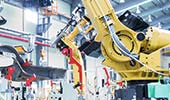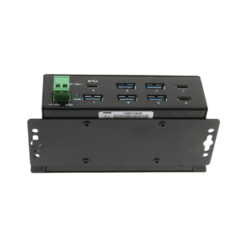Bulk Pricing
4 Port USB 3.2 Gen 1 Hub w/ Screw-Locking Ports & Status LEDs
Industrial Grade | +7~24V DC Input | Surface Mountable | 5 Gbps | LED Indicators
- Super Fast Speeds: This USB hub is 3.2 Gen 1 compliant, ensuring super-fast 5Gbps data transfer speeds. It supports super speed, high speed and full speed which enables it to be compatible with USB 2.0 / 1.1.
- Superior Build Quality: Housed in a rugged steel chassis with built in mountable flanges, the 4-port hub is perfect for installations in offices, labs, warehouses, heavy machinery, automation equipment, and other industrial applications.
- Check Your Ports’ Status: Quickly check the status of each port individually with built in LED indicators.
- Upstream: 1 USB port, Type B connector, Screw-lock type
- Downstream: 4 USB ports, Type A connectors, Screw-lock type
- Power Connector: 2-Pin Terminal Block, DC Barrel 2.1mm ID × 5.5mm OD
- Mounting Options: Wall & Surface
- Supply Current: 900mA USB Bus Power for Each Down-stream Port
$87.95
In stock
Volume Pricing
| Units | Discount | Price |
|---|---|---|
| 1 - 4 | — | $87.95 |
| 5 - 11 | 2 % | $86.19 |
| 12 - 24 | 5 % | $83.55 |
| 25 - 49 | 7 % | $81.79 |
| 50+ | 10 % | $79.16 |
Description
Introduction:
The USBG-3X4M USB 3.2 Gen 1 4-Port Industrial hub with power supply provides 4 downstream facing ports with standard Type-A USB 3.2 Gen 1 connectors. It supports screw-lock features for both upstream (USB type B) and downstream (USB type A) connectors with the screw-lock USB cables. The screw-lock features are a preventative measure against accidental disconnection from the USB cables and hub.
With built-in single chip USB 3.2 Gen 1 controller, it is backward compatible either when any one of downstream port is connected to an USB 1.1 or USB 2.0 compliant device, or when the upstream port is connected to a USB 1.1 or USB 3.2 Gen 1 compliant host.
The USBG-3X4M USB 3.2 Gen 1 4-Port Industrial Hub design incorporates dual power conversion systems. This allows the hub to provide the USB 3.2 Gen 1 specification maximum of 900ma current on each port. There is no other USB 3.2 Gen 1 hub currently on the market that can provide this much power to all connected devices, simultaneously.
Features:
- Compliant with USB 3.2 Gen 1 Specification Revision 1.0
- Rigid and Wall-mountable metal case
- Provides 4 Downstream ports
- Supports Screw Lock Mechanism for Upstream and Downstream connectors to enhance reliability
- Supports SuperSpeed, High-Speed, and Full-Speed (USB 3.2 Gen 1, 2.0, and 1.1)
- Supports Self-powered and Bus-powered modes.
- Supports 900MA Buss Power for each Downstream Port (When using external power supply).
- Dimensions: 6.013in(L) 7.013 (w/flange) x 2.350(W) x .955in(H)
- Hub Weight: .65 lbs.
OS Support:
- Windows XP, 2000, 2003, CE, Vista, Windows 7, 8, and Windows 10
- Linux and Mac OS 10.X
Environmental Specification:
- Operating Temp: 0 to 55°C (32 to 131°F)
- Operating Humidity: 5 to 95% RH
Package Contents:
- USB 3.2 Gen 1 4 port industrial hub
- USB 3.2 Gen 1 A to B cable
- 12V 3A output power adapter and power cord
- 2 pin Phoenix power connector
- Paper installation guide
*Surface Mounting screws not included.
Accessories & Replacement Parts
Accessories & Replacement Parts
Model# 12V7A2P-B
$29.95In stock
Model# CG-2PPW
$2.95In stock
Model# ABMSL-USB3-5FT
$10.95In stock
Specifications
Product Specifications
| Power |
| ||||||||||||||||||||
|---|---|---|---|---|---|---|---|---|---|---|---|---|---|---|---|---|---|---|---|---|---|
| Compliance |
| ||||||||||||||||||||
| Physical Characteristics |
| ||||||||||||||||||||
| What's in the Box |
| ||||||||||||||||||||
| Software |
| ||||||||||||||||||||
| Environmental |
| ||||||||||||||||||||
| Product Information |
| ||||||||||||||||||||
| Hardware |
| ||||||||||||||||||||
| Performance & Safety |
| ||||||||||||||||||||
| Other Data |
|
Reviews (11)
11 reviews for 4 Port USB 3.2 Gen 1 Hub w/ Screw-Locking Ports & Status LEDs
Add a review
Support
Product Documentation & Drivers
Product Documentation
Need drawings, CAD files, or other compliance documentation? Click HERE
Relevant Articles & F.A.Q.
Relevant Articles
Product F.A.Q.
View frequently asked product questions below. Still need help? Reach out!
-
Can the hub be used without a power supply?
View AnswerIn some cases, yes. USB peripherals that only require low power (i.e. keyboards & mice) can be used without a power adapter. Power in this case is drawn from the host’s USB port.
When high-power USB peripherals are used, a power supply for the USB hub may be required. In other cases, the USB peripheral may require their own power adapters, in this case, a power supply for the hub may not be required. Without ample power though, the USB hub or connected peripherals may not operate correctly. It is recommended to use an included power supply when possible.
-
After waking up from sleep mode, my computer/host no longer recognizes my USB device.
View AnswerIf the USB device does not function properly after your computer or host has been in sleep mode, it is likely that Windows turned off the USB Root hub in order to save power.
To prevent this, follow the steps below (depending on your operating system).
Windows 10 / 8
- On your keyboard, press the Windows key + X and select Control Panel.
- Click Hardware and Sound, then click Power Options.
- Click Change plan settings for the plan you want to change.
- Click Change advanced power settings.
- Click the plus sign (+) next to “USB settings” and “USB selective suspend setting” to expand the options and change the setting to Disabled.
- Click OK to apply the setting.
Note: You may need to disconnect and re-connect your USB device after applying these settings.
Windows 7 / Vista
- Click the Start button and select Control Panel.
- Click Hardware and Sound, then click Power Options.
- Click Change plan settings for the plan you want to change.
- Click Change advanced power settings.
- Click the plus sign (+) next to “USB settings” and “USB selective suspend setting” to expand the options and change the setting to Disabled.
- Click OK to apply the setting.
Note: You may need to disconnect and re-connect your USB device after applying these settings.
Windows XP
- On your desktop, right-click the My Computer icon and select Properties.
- Click the Device Manager tab.
- Expand Universal Serial Bus controllers by clicking the arrow to the left of it.
- Right-click the first USB Root Hub device and select Properties.
- Click the Power Management tab.
- Clear the box next to Allow the computer to turn off this device to save power.
- Click OK to apply the setting.
- Repeat steps 4-7 for any remaining devices in the Universal Serial Bus Controllers section with “Root Hub” in the name.
Note: You may need to disconnect and re-connect your USB device after applying these settings.
-
The hub is properly hooked up, but is not functioning correctly. What can I do?
View AnswerTesting all setup components is the best place to begin troubleshooting. To determine the source of the issue, individually test your:
- USB Cable by using it in another setup, or trying another cable.
- Host USB Port by connecting another device or thumb drive.
- Connected Peripherals by connecting directly to the host.
Moving on to troubleshooting the hub itself. Attach a USB peripheral. The USB hub itself will not appear in hardware listings on your host’s system. USB devices connected however, will appear when connected. If the connected device is still not being found, try:
- Installing the required drivers for the USB peripheral.
- Install the most recent drivers for the USB controller and/or motherboard chipset.
USB hubs do not require drivers or software.
Troubleshooting the desired USB peripheral may be in order. If the peripheral is still not being recognized, attempt:
- Attaching external power to the peripheral, if required.
- Confirming if the peripheral functions on a standard USB port.
- Testing if basic USB peripherals work, such as keyboards or mice.
-
How can external power be connected to the industrial USB hub?
External power is supplied by connecting to the terminal block located on the hub. For when an external power adapter is required check out the Accessories & Replacement Parts section on this product page. To view all of our hub accessories and power supplies, visit the category here.
How to properly choose a power supply.To determine the power requirements, the equation to use is P = 5 * I * N, where:
P is the power wattage.
5 is the USB port voltage.
I is the current of the USB port in Amps (USB 2.0 is 0.5A, USB 3.0 is 0.9A.
N is the number of USB ports.
As an example using the equation, a 4 port hub would reflect a minimum wattage of 18 watts.
Knowing the minimum requirement, a proper power adapter can be chosen. In this case the voltage of a power supply should be within 7 to 24 or 7 to 40 Volts DC, depending on the specifications of the USB hub. Also, the power supply must convert AC to DC (no AC output).
Power supplies often come with a voltage (V) rating and an amperage (A) rating. To determine the current in amps, use I = P / V, where the following is true:
I is the current of the power supply.
P is the calculated power of the hub.
V is the chosen voltage of the power supply
Continuing the example, the 4 port hub requires 18 W and the power supply you choose is 12V, the current of the power supply would be I = 18/12, I = 1.5A.
Our full collection of power adapters can be found here.























































Scott of the family Larson “Connecting your world by simplifying technology” –
After doing extensive research on a hub that would be capable of handing my USB 3 along with my legacy devices I choose this device because I wanted a heavy duty hub that didnt move around. One that I could mount to my desk and work really well with all kinds of devices. It has a Transaction Translator Chip so slower devices do not cause the performance issues with faster devices which is a big issue for me with other USB hubs.
Unfortunately I had a problem with a headset I tried to use with the CoolGear USB 3.0 4-Port Industrial Hub. The headset I use is a Plantronics GameCom 780 Surround Sound Stereo PC Gaming Headset. When I plug this headset into the USB hub the head set would work for a short time and and then It would just lose connectivity to the device from within my applications. It would still show up in the device manager but would not work in my applications.
I contacted the company by email twice. The first time I got no response, A month went by with no response, I emailed them again asking why they had not gotten back to my email. I got a response: “Sorry,
We have been unable to duplicate this issue in our lab (using other USB headphones). I would suggest you contact Plantronics to see if they have any recommendations.”
Basically passing it off to the manufacturer of the headset when the headset works fine on with USB directley attached to the computer. Obviously they didnt really do the work necessary to find out what was the cause of the problem. So I contact them by phone a tech answered and I started to explain my problem as I got half way though the conversation I didn’t get any feed back from him so I asked if he was still there. Got no reply on the other end just dead silence.
Frustrated I contacted there sales department and explained the problem. He got right on it and said he would test the device and get back to me via email. A couple of days later I got an email stating the device is unsupported by the equipment and they offered to give me a refund.
I feel like I didn’t get good customer support, and I did feel like they were not interested in handling my issue until I found someone higher up that was willing to deal with this problem. All though the last person I spoke to did his best to help me I feel like they could go much further and offer a reason to why its not working and what the plan on doing in the future to fix this problem so I could have at least have trust in the fact that they know what they are doing and plan on resolving it in the future in case there support issues were a fluke and I wanted to purchase any products from them in the future.
At this point I cant recommend buying a product from this company simply because they don’t have there act together enough to handle support issues. There support department seems lax beyond belief.
In the meantime I think I will still use it for my other devices or im going to do some research on another industrial product that is comparable. If any one has any recommendations please let me know.
Eric Hyde –
Purchased 2 of these for a critical install with a 2013 iMac 27 and a set of 4TB UASP Enabled External Drives/Enclosures. Dressed out of the way in 2 positions, a 3 to 1st port and 2 to 2nd port.
The most important issue was not slowing down the new drives. Very few hubs have a quality power supply, B uplink connector, and rigid case. In my instance, the design of the case with it’s screw mounting was a huge plus. As another reviewer noted, it’s not pretty.
This “Function Over Form” design was the very thing that attracted me to the product. The ground connector was not used in my installation, but it’s an interesting detail for those who would use it on or around metal.
I didn’t trust the word “Industrial” until I had one open to see how it was made. These days, marketing lies at every turn. This might actually deserve the term if you pair it with quality 3.0 cables. Good luck
Highly Recommended
Richard Collier –
Perfect hub for that tucked-away back corner, behind a bunch of drives where it’s hard to reach. This is a heavyweight, metal box that will stay put, making it easy to plug, unplug, and generally ignore. It’s heavy enough not to be shoved or pulled around by the weight of cables. (But then, it is also pretty industrial in appearance — not all light, sleek, and plastic like many. You probably won’t want to put it out on your desk where you will always be looking at it.) Unlike lighter and less expensive hubs I’ve tried, this one does not randomly disconnect or give any problems. I attached the thing the day it arrived (tucked away in the back of a shelf), connected four peripheral drives, and have not had to mess with it since. For the first time in years, all my remote peripherals are staying connected and I’m not getting any messages about how my devices could perform faster. Though it is more expensive than others, it is worth the price if your budget permits.
Robert –
I’ve gone through a massive number of hubs trying to find one that could power 2.5 drives and also charge an iDevice. This hub not only performs flawlessly, but it looks and feels like a quality piece of hardware. Obviously the price point is a factor, but other hubs are getting close to this cost without even touching this one on quality. If you are struggling to find a USB2/3 hub that will end your search, this is it.
Chrisroman –
I have the little brother, 8 port USB 2.0 hub, which has been faithful and troublefree for over a year. I needed another hub and opted for the USB 3.0, since that is the new standard. The unit is just as solid and reliable as it USB 2.0 hub, but I find the lights on this unit annoying. I understand why they’re there, but when it’s sitting on your desktop as mine is, this is very distracting. A switch to disable the lights would have been nice. Other than that, it is a very solid, well made hub. I would buy again.